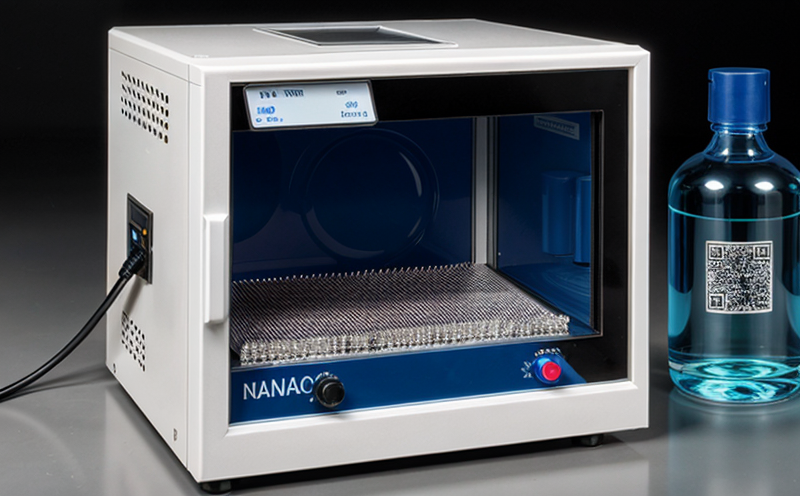EPA 8270 Organic Compound Testing in Nanomaterials
The EPA 8270 test method is a comprehensive protocol designed to assess and identify organic compounds in nanomaterials. This stringent testing ensures compliance with environmental regulations, particularly relevant for industries dealing with engineered nanoparticles that can have unique chemical properties due to their size, shape, or surface characteristics.
The EPA 8270 methodology leverages advanced chromatographic techniques including gas chromatography and liquid chromatography coupled with mass spectrometry (GC/MS and LC/MS). These instruments allow for the detection of trace amounts of organic compounds that might otherwise go undetected in conventional testing. The process involves several critical steps, starting from sample preparation where nanomaterials are dissolved or dispersed to ensure even distribution for accurate analysis.
The test is particularly important for industries such as pharmaceuticals, cosmetics, and environmental remediation, where the potential environmental impact of nanomaterials must be assessed meticulously. The results of this testing play a crucial role in determining whether these materials pose risks that need further investigation or regulation.
Compliance with EPA 8270 is not just about meeting legal requirements; it's also about ensuring product safety and protecting the environment. By adhering to this protocol, businesses can demonstrate their commitment to sustainable practices and responsible manufacturing.
The testing procedure involves several key stages: sample collection, preliminary screening for organic compounds, extraction of target analytes using appropriate solvents, clean-up procedures to remove interferences, derivatization if necessary (to enhance detection), injection into the chromatographic system, data acquisition and interpretation, and finally, reporting results.
The high sensitivity and specificity of EPA 8270 make it a preferred choice for identifying even trace amounts of organic contaminants in nanomaterials. This is particularly important because some nanoparticles can leach or release organic compounds into the environment over time, posing potential risks to human health and ecosystems.
For instance, in pharmaceutical applications, understanding the breakdown products of drug-delivery nanoparticles helps ensure that any released chemicals do not accumulate at levels harmful to patients or the public. In environmental contexts, this testing aids in assessing whether engineered nanomaterials used for water purification could inadvertently release toxic substances into treated waters.
The competitive landscape is increasingly focused on sustainable and eco-friendly practices, making EPA 8270 a valuable tool not just for regulatory compliance but also for enhancing brand reputation. Companies that can demonstrate compliance with this stringent standard are seen as leaders in their field, setting benchmarks for responsible manufacturing processes.
Customer Impact and Satisfaction
Implementing EPA 8270 Organic Compound Testing in Nanomaterials has several significant impacts on our clients:
- Enhanced Compliance: Ensures strict adherence to environmental regulations, reducing the risk of legal penalties.
- Risk Mitigation: Identifies potential environmental hazards early, allowing for corrective actions before they escalate into larger issues.
- Improved Product Quality: Guarantees that nanomaterials are safe and effective, enhancing product reliability and customer trust.
- Sustainable Brand Image: Demonstrates a commitment to sustainability, which is increasingly important for consumer loyalty and market positioning.
Our clients benefit from the peace of mind that comes with knowing their products meet rigorous international standards. This not only opens up new markets but also strengthens existing relationships by showcasing a proactive approach to quality and safety.
We work closely with our customers throughout the testing process, providing detailed reports and actionable insights based on our findings. This collaborative approach ensures that any necessary adjustments can be made swiftly, minimizing disruptions to production schedules while maintaining high standards of integrity and accuracy.
International Acceptance and Recognition
The EPA 8270 test method is widely recognized internationally for its robustness and reliability. It aligns with ISO standards for environmental analysis, ensuring that the results are accepted globally. This international acceptance makes it an essential tool for companies operating in multiple jurisdictions or those exporting products to countries that have stringent regulations regarding nanomaterial safety.
Many global regulatory bodies recommend or require EPA 8270 testing when evaluating the potential environmental impact of engineered nanoparticles. By adhering to this protocol, businesses can ensure their compliance with international standards and demonstrate their commitment to responsible manufacturing practices.
The recognition extends beyond mere compliance; it also reflects a proactive stance towards sustainability and safety. This is particularly valuable in sectors like pharmaceuticals, cosmetics, and electronics, where the environmental footprint of products can have far-reaching consequences if not managed properly.
Competitive Advantage and Market Impact
- Innovation Leadership: By staying ahead in compliance with EPA standards, businesses can lead the market in responsible manufacturing practices.
- Better Decision-Making: Accurate data from EPA 8270 testing allows for informed decisions on product development and regulatory strategies.
- Enhanced Reputation: Demonstrating commitment to environmental safety enhances brand reputation, attracting more customers and investment.
- Ongoing Market Access: Compliance with international standards ensures continuous market access without the risk of export bans or import restrictions.
These advantages position companies not just as compliant entities but also as leaders in sustainable practices. This is particularly crucial in today’s market, where consumer awareness and demand for eco-friendly products are growing exponentially.





